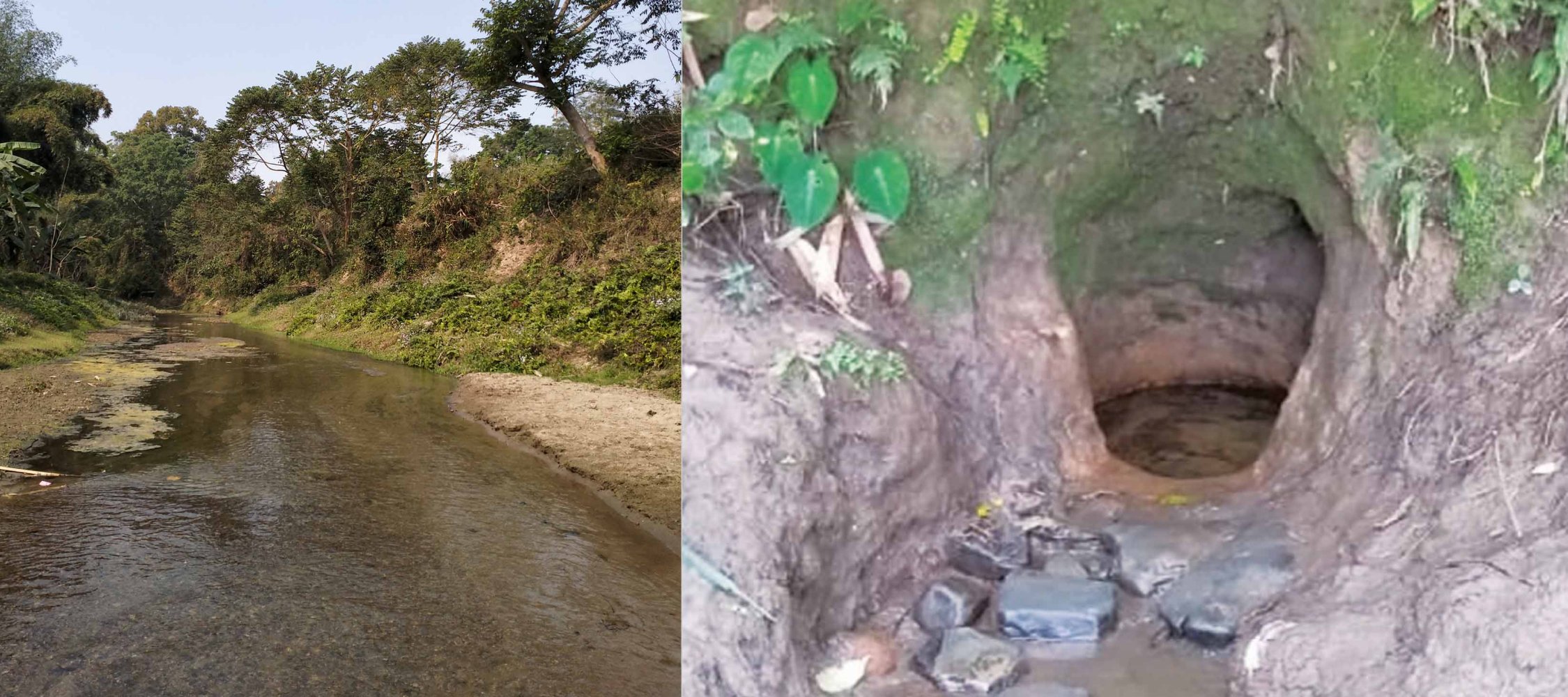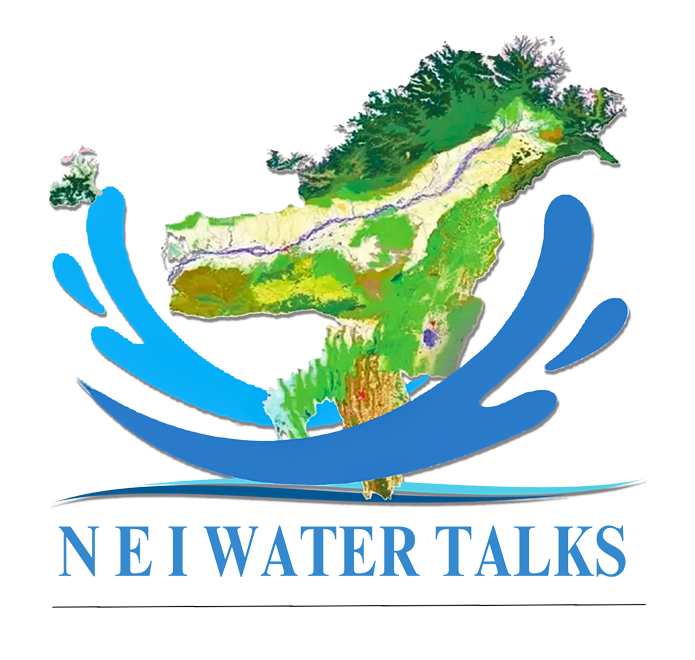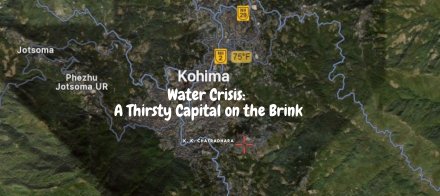 |
At the heart of Killa, one of the forested villages in the Sipahijala district of Tripura, throbs a running stream – Bhurma Tuipui. The tiny nondescript hamlet is inhabited largely by the indigenous Hrangkhwal community, which calls this hill stream as its saviour. In their local tongue, bhurma means ‘mother’ and tuipui (tui means ‘water’ and ‘pui’ means ‘huge’) refers to a ‘huge water’ body, suggesting that once this tiny stream may have been a deep stream.
“We Hrangkhawls have relied on this stream for as long as I can remember,
and it has met our basic needs – from drinking to cultivation,”
In fact, there is a popular saying among the Hrangkhawls who describe the Bhurma Tuipui as thus: ‘Bhurma nu chu lung switu ani,’ which means that the Bhurma is like a very warm and kind mother who looks after, cares for, and fulfils all the needs of her children. Villagers say the Bhurma Tuipui has become an integral part of their daily lives, as it had been in the past serving their ancestors from the time immemorial. “We Hrangkhawls have relied on this stream for as long as I can remember, and it has met our basic needs – from drinking to cultivation,” said a village elder. Killa, which earlier was also known as ‘Rajaituiva’, is said to be the first Hrangkhawl village in Tripura. Subsequently, they spread out in other districts.
Earlier, it was a pristine gurgling stream, but over the years it had lost much of its force and charm as much as its character; its bed is now filled in silt and sand due to denudation of catchment forest and resultant loss of soil. So, with the rising river bed during the monsoon, water overflows its banks, causing floods all over the area.
Bhurma: the lifeline for the local community
The Bhurma emerges from the lower hills of the Baramura range, part of which extends up to the Jampuijala sub-division of the Sipahijala district. The Hrangkhawls are one of the smaller indigenous tribal communities in Tripura. They have also settled in the districts of Dhalai, and Khowai. They share their ancestral kinship with Chin-Kuki-Mizo ethnic groups.
The Hrangkhawls founded the village at Killa along the Bhurma stream that met much of their daily water needs. Its water was so clean that they used it for drinking purposes and never bothered to dig ponds or wells in the village. Elders also recalled the abundance of native fish and other edible aquatic resources like snails, prawns and crabs. In the past, elders say, the Hrangkhawl people used to go to Bhurmatuipui for community fishing, known as rudeng. It’s actually an ingenious fishing technique, which requires group efforts. People collect different kinds of jungle creepers, plant roots, and barks, and spread them across the flowing river upstream. As these wild plant materials come in touch with water, it creates a shocking effect that temporarily stuns the fishes. Few moments later all the fishes come afloat over the surface water, while people eagerly wait downstream to collect them. The entire village participates in rudeng on a particular day decided by the community. Some people use fishing traps – chok or kangvarpa – made of cane and bamboo, which are placed in some stretches of the running stream allowing water flow through the fish traps. As fishes swim along the flow they easily get trapped inside the chok.
Villagers also grew crops and vegetables on the riverbank irrigating them using the easily available water. Thus, a natural bond evolved between the Hrangkhawals and the life-giving Bhurma Tuipui. Hrangkhawls, especially the elders, believe that land, forest, and water sustain their lives and thus they are worshipped as sacred deities or gods and goddesses. “Nowadays, people profess different religions like Hinduism and Christianity and they worship different gods and the deities can be seen in the form of idols, statues and photographs in temples or churches,” observed an ochai (local priest). “But land, forest and water – we can see them, touch them, and find intimate connection by way of recognising how they take care of the very basic needs of our existence. So, for me, these are my gods and goddesses.” In this way, Bhurma Tuipui, too, is a life-sustaining deity. And it was this symbiotic relationship between the Bhurma Tuipui and the Hrangkhawls, which elevated the status of the village stream from a mere natural resource to a spiritual entity.
Bhurma: the Abode of Water Spirit
In contrast to the dominant perspective, which views water only as a resource, the Hrangkhawals, like other indigenous peoples, have cultivated a deeper meaning of water, which is expressed through various water and river rituals and ceremonies. This deep-rooted connection between the indigenous communities and water is based on their traditional ecological knowledge and practices. Therefore, for the Hrangkhawls, BhurmaTuipui is not just a village stream; rather, it has emerged as a sacred living being, which has to be propitiated for the wellbeing of the community. For example, there is this sacrificial ritual or ceremony, called Tui Chubai Un; it is one of the offerings made to obtain blessings from the Water Goddess. This water or river ceremony of Bhurma Tuipui has been offered for many years. However, it has declined dramatically over time. And carrying on with this ceremony or ritual is now considered a sign of backwardness.
Earlier, for the Hrangkhawls, a water ritual was a ceremony in which people collectively honoured water as a life-giving spiritual force by making offerings and singing during the ceremony. A banana, chicken, and a handful of flowers were offered as part of a water-honouring ritual. Along with these items, the scent of the burning sage wafted, which they called sutarai, and they scattered flower petals on the surface of the water. They believed that the water was alive and contained a spirit.
It is believed that the Bhurma used to alleviate their grievances and fulfil all of their wishes and needs. Some say, one could even borrow money from it! For that, the community usually performed sacrificial rituals near the riverbank, and placed sticks worth the amount desired. In the morning, coins appeared in place of the sticks, and they collected them, according to the belief.
The Healing power of Bhurma
The Hrangkhawls believe that the Bhurma has healing powers too! According to the community, people can heal sickness or get rid of diseases by simply performing a water ritual in the Bhurma Tuipui. Martin, one of the villagers, claimed that “sometimes when there is joint sore in the body, or it develops some kind of disease and medication fails to work, our Bhurma water can heal.” When any of the family members becomes ill, they believe the Bhurma river can heal them. For this, they perform a sacrificial water ritual. They called it nu sakpek, which translates as ‘mother feeding’ or ‘feeding the mother’. They offer sacrifice to the flowing water during this process, believing that the Water Goddess would cure their illnesses in the same way that river water flows and cleanses the river water. Although the Hrangkhawls’ belief in spirits in the Bhurma river is fading, they still honour and respect it. It is also believed that when it does not rain, the community performs a river ceremony involving sacrificial rituals, after which they believe there will be rain.
Also, during the jhum (shifting/ slash and burn) cultivation process, especially following the burning, the villagers would take bath in the Bhurma river to cleanse all the ashes from the body. Even today, some households perform sacrificial river rituals of tui chubai un, a ceremony to honour ‘Bhurma’, who was known for her kindness and generosity. The offerings in the river water are also meant to express their gratitude for the blessing, as the water has aided the community in a variety of ways. Even from other communities, a Jamatia man is said to have discovered a gold jar and still sacrifices a buffalo once a year.
Current Problems
The Hrangkhawls often ponder over the serene surroundings of the area where their ancestors had settled amidst clean and plentiful resources, especially water. In fact, they had an enriching water relationship in the past, but that relationship seems to have weakened due to a variety of factors. One of them is the commoditisation of nature and its resources, in the name of economic development. Large areas of natural forest with large trees, some of which are considered sacred, have been cleared for promotion of commercial plantation and cash crops, such as rubber, areca nut and tea. All this has led to deforestation and degradation of land, and also adversely affected the water bodies in various parts of the state.
The so-called educated younger generation is quite sceptical about the indigenous worldview that articulates a deeper connection with nature and cultivates a lifestyle that promotes a harmonious relationship with nature. Many with their modern logical mind failed to recognise any value in such ideas, or folk tales or songs in relation to nature. They display little or no interest in such narratives, and instead, look for economic opportunities, irrespective of social and environmental cost, that help improve their financial situation and material comfort that bring happiness in their life.
Another important factor that is attributed to the loss of the traditional belief system of nature worshipping is the religious conversion to Christianity, which was embraced by many indigenous communities in Tripura. Earlier, the Hrangkhawls believed in Ninu-Thapa (worshipping of sun to moon), among other nature gods and goddesses, including Water Goddess like Tui Chubai Un, Lungpui or Tuipui (worshipping of large stones, big trees or lakes), and Tuikel Tan (worship of water by offering goats, chicken and fowl to seek their blessings for the wellbeing of the community). However, after many of them embraced Christianity, they stopped nature worshipping and thereby abandoned the traditional ecological knowledge and practices associated with it. Hence, they believe the water crisis that the community is facing today may be the result of loss of their ancestral ecological knowledge and traditional practices associated with protection and conservation of water bodies they considered sacred.
Unfortunately, the Bhurma is decaying fast, and the Hrangkhawl community is facing acute shortage of drinking water. The Bhurma, which earlier had a healing power with its pure water, is now unfit for human consumption. There is no other source of drinking water in and around their village. There is a public tube well installed in the village, but it is hardly operational. So, the community is now digging mud well near the Bhurma Tuipui for water. They collect water from a riverside handmade mud well known as Bhurma kowa. About 30 families in the village solely depend on Bhurma kowa for meeting their drinking water needs. If the river is flooded during the rainy season, they don’t have water to drink or take bath, so they collect rainwater in their vessels or pots to drink and for other domestic uses. They get good water as long as the weather is nice and pleasant.
As a Hrangkhawl resident put it: “Earlier, there was more than enough for everyone, but today, with a rise in individualism and material possession, there is no more spiritual connection with natural resources like water and forest.”
About the writer:
Thomas Malsom is currently a Ph.D. scholar at the Department of Sociology, North-Eastern Hill University, Shillong, Meghalaya. His research interests include sociology of development, tribal/ indigenous studies, and social policy. His research works have been published in the journals “Economic and Political Weekly (India)” and “Intersectionalities: A Global Journal of Social Work Analysis, Research, Polity and Practice(Canada)”. He is also co-author with Walter Fernandes of the book entitled “Ethnicity and Land Conflicts: Development-Induced Displacement in Tripura 1947-2010”. (mcthomashlutie@gmail.com, +929862492971)
Geolocation is 23.427059, 93.281158


